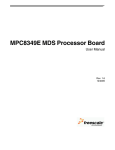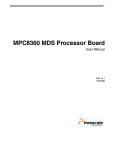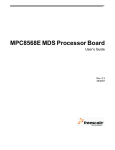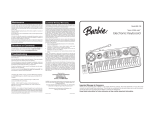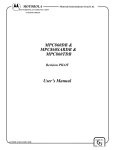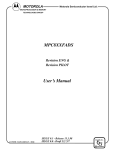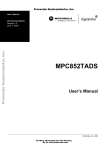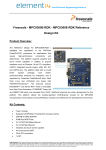Download MPC8349EA MDS Processor Board User Manual
Transcript
MPC8349EA MDS Processor Board User Manual Rev. A 12/2006 MPC8349EA MDS Processor Board, Rev. A ii Freescale Semiconductor Contents Chapter 1 General Information 1.1 Introduction. . . . . . . . . . . . . . . . . . . . . . . . . . . . . . . . . . . . . . . . . . . . . . . . . . . . . . . . . . . . . . . . . 1.1.1 MPC8349EA MDS Processor Board . . . . . . . . . . . . . . . . . . . . . . . . . . . . . . . . . . . . . . . . . . 1.1.2 MPC8349EA MDS vs. MPC8349E MDS Differences . . . . . . . . . . . . . . . . . . . . . . . . . . . . 1.1.3 Working Configurations . . . . . . . . . . . . . . . . . . . . . . . . . . . . . . . . . . . . . . . . . . . . . . . . . . . . 1.1.3.1 Stand-Alone: . . . . . . . . . . . . . . . . . . . . . . . . . . . . . . . . . . . . . . . . . . . . . . . . . . . . . . . . . . 1.1.3.2 With PIB board (PIB Combined Mode): . . . . . . . . . . . . . . . . . . . . . . . . . . . . . . . . . . . . 1.1.3.3 PCI Add-On (Agent Mode): . . . . . . . . . . . . . . . . . . . . . . . . . . . . . . . . . . . . . . . . . . . . . . 1.2 Definitions, Acronyms, and Abbreviations . . . . . . . . . . . . . . . . . . . . . . . . . . . . . . . . . . . . . . . . 1.3 Related Documentation. . . . . . . . . . . . . . . . . . . . . . . . . . . . . . . . . . . . . . . . . . . . . . . . . . . . . . . . 1.4 Specifications . . . . . . . . . . . . . . . . . . . . . . . . . . . . . . . . . . . . . . . . . . . . . . . . . . . . . . . . . . . . . . . 1.5 MPC8349EA MDS Processor Board Features . . . . . . . . . . . . . . . . . . . . . . . . . . . . . . . . . . . . . . 1.6 External Connections . . . . . . . . . . . . . . . . . . . . . . . . . . . . . . . . . . . . . . . . . . . . . . . . . . . . . . . . . 1.7 Block Diagram . . . . . . . . . . . . . . . . . . . . . . . . . . . . . . . . . . . . . . . . . . . . . . . . . . . . . . . . . . . . . . 1-1 1-1 1-2 1-2 1-2 1-2 1-2 1-3 1-4 1-4 1-5 1-6 1-8 Chapter 2 Hardware Preparation and Installation 2.1 Unpacking Instructions . . . . . . . . . . . . . . . . . . . . . . . . . . . . . . . . . . . . . . . . . . . . . . . . . . . . . . . . 2.2 Installation Instructions. . . . . . . . . . . . . . . . . . . . . . . . . . . . . . . . . . . . . . . . . . . . . . . . . . . . . . . . 2.2.1 Stand-Alone mode . . . . . . . . . . . . . . . . . . . . . . . . . . . . . . . . . . . . . . . . . . . . . . . . . . . . . . . . 2.2.2 For PIB combined mode only . . . . . . . . . . . . . . . . . . . . . . . . . . . . . . . . . . . . . . . . . . . . . . . . 2.2.3 For Agent mode only . . . . . . . . . . . . . . . . . . . . . . . . . . . . . . . . . . . . . . . . . . . . . . . . . . . . . . 2-1 2-1 2-1 2-3 2-9 Chapter 3 Memory Map 3.1 MPC8349EA MDS Processor Board Mapping . . . . . . . . . . . . . . . . . . . . . . . . . . . . . . . . . . . . . 3-1 Chapter 4 Controls and Indicators 4.1 4.1.1 4.1.2 4.2 4.2.1 4.2.2 4.2.3 4.2.4 4.2.5 Switches and Jumpers Locations . . . . . . . . . . . . . . . . . . . . . . . . . . . . . . . . . . . . . . . . . . . . . . . . Switches . . . . . . . . . . . . . . . . . . . . . . . . . . . . . . . . . . . . . . . . . . . . . . . . . . . . . . . . . . . . . . . . Jumpers . . . . . . . . . . . . . . . . . . . . . . . . . . . . . . . . . . . . . . . . . . . . . . . . . . . . . . . . . . . . . . . . . LEDs . . . . . . . . . . . . . . . . . . . . . . . . . . . . . . . . . . . . . . . . . . . . . . . . . . . . . . . . . . . . . . . . . . . . . . LD1, LD2 - Signaling LEDs. . . . . . . . . . . . . . . . . . . . . . . . . . . . . . . . . . . . . . . . . . . . . . . . . LD3 - USB Power. . . . . . . . . . . . . . . . . . . . . . . . . . . . . . . . . . . . . . . . . . . . . . . . . . . . . . . . . LD4, LD5 - GETH Enable . . . . . . . . . . . . . . . . . . . . . . . . . . . . . . . . . . . . . . . . . . . . . . . . . . LD6 - DUART Enable . . . . . . . . . . . . . . . . . . . . . . . . . . . . . . . . . . . . . . . . . . . . . . . . . . . . . LD7 - FUNC Indication . . . . . . . . . . . . . . . . . . . . . . . . . . . . . . . . . . . . . . . . . . . . . . . . . . . . 4-1 4-2 4-3 4-4 4-4 4-4 4-4 4-4 4-4 MPC8349EA MDS Processor Board, Rev. A Freescale Semiconductor i 4.2.6 LD8 - Power GOOD . . . . . . . . . . . . . . . . . . . . . . . . . . . . . . . . . . . . . . . . . . . . . . . . . . . . . . . 4.2.7 LD9 - GPIO1-1 Indication . . . . . . . . . . . . . . . . . . . . . . . . . . . . . . . . . . . . . . . . . . . . . . . . . . 4.2.8 LD10, LD11 - PCTL0,1 USB . . . . . . . . . . . . . . . . . . . . . . . . . . . . . . . . . . . . . . . . . . . . . . . . 4.2.9 LD12 - BOOT Indicator . . . . . . . . . . . . . . . . . . . . . . . . . . . . . . . . . . . . . . . . . . . . . . . . . . . . 4.2.10 LD13 - 5V Power Indicator . . . . . . . . . . . . . . . . . . . . . . . . . . . . . . . . . . . . . . . . . . . . . . . . . 4.3 Other Controls and Indicators. . . . . . . . . . . . . . . . . . . . . . . . . . . . . . . . . . . . . . . . . . . . . . . . . . . 4-4 4-4 4-4 4-4 4-4 4-5 Chapter 5 Functional Description 5.1 Reset & Reset - Configuration . . . . . . . . . . . . . . . . . . . . . . . . . . . . . . . . . . . . . . . . . . . . . . . . . . 5-1 5.1.1 Power - On Reset . . . . . . . . . . . . . . . . . . . . . . . . . . . . . . . . . . . . . . . . . . . . . . . . . . . . . . . . . 5-1 5.1.2 Hard Reset. . . . . . . . . . . . . . . . . . . . . . . . . . . . . . . . . . . . . . . . . . . . . . . . . . . . . . . . . . . . . . . 5-1 5.1.2.1 COP/JTAG Port Hard - Reset (stand-alone only). . . . . . . . . . . . . . . . . . . . . . . . . . . . . . 5-2 5.1.2.2 Manual Hard Reset . . . . . . . . . . . . . . . . . . . . . . . . . . . . . . . . . . . . . . . . . . . . . . . . . . . . . 5-2 5.1.2.3 Manual Soft Reset. . . . . . . . . . . . . . . . . . . . . . . . . . . . . . . . . . . . . . . . . . . . . . . . . . . . . . 5-2 5.2 Board Control & Status Registers – BCSR . . . . . . . . . . . . . . . . . . . . . . . . . . . . . . . . . . . . . . . . 5-2 5.2.1 BCSR0 - Board Control / Status Register 0 . . . . . . . . . . . . . . . . . . . . . . . . . . . . . . . . . . . . . 5-3 5.2.2 BCSR1 - Board Control / Status Register 1 . . . . . . . . . . . . . . . . . . . . . . . . . . . . . . . . . . . . . 5-4 5.2.3 BCSR2 - Board Control / Status Register 2 . . . . . . . . . . . . . . . . . . . . . . . . . . . . . . . . . . . . . 5-4 5.2.4 BCSR3 - Board Control / Status Register 3 . . . . . . . . . . . . . . . . . . . . . . . . . . . . . . . . . . . . . 5-5 5.2.5 BCSR4 - Board Control / Status Register 4 . . . . . . . . . . . . . . . . . . . . . . . . . . . . . . . . . . . . . 5-6 5.2.6 BCSR5 - Board Control / Status Register 5 . . . . . . . . . . . . . . . . . . . . . . . . . . . . . . . . . . . . . 5-7 5.2.7 BCSR6 - Board Misc. Register 1 . . . . . . . . . . . . . . . . . . . . . . . . . . . . . . . . . . . . . . . . . . . . . 5-8 5.2.8 BCSR7 - Board Misc. Register 2 . . . . . . . . . . . . . . . . . . . . . . . . . . . . . . . . . . . . . . . . . . . . . 5-8 5.2.9 BCSR8 - Board Misc. Register 3 . . . . . . . . . . . . . . . . . . . . . . . . . . . . . . . . . . . . . . . . . . . . . 5-9 5.2.10 BCSR10 - Board Status Register 1 . . . . . . . . . . . . . . . . . . . . . . . . . . . . . . . . . . . . . . . . . . . 5-10 5.2.11 BCSR11 - Board Status Register 2 . . . . . . . . . . . . . . . . . . . . . . . . . . . . . . . . . . . . . . . . . . . 5-10 5.2.12 CCR - COP Control Register . . . . . . . . . . . . . . . . . . . . . . . . . . . . . . . . . . . . . . . . . . . . . . . 5-11 5.3 External Connections . . . . . . . . . . . . . . . . . . . . . . . . . . . . . . . . . . . . . . . . . . . . . . . . . . . . . . . . 5-12 5.3.1 P1 - MiniAB USB Connector . . . . . . . . . . . . . . . . . . . . . . . . . . . . . . . . . . . . . . . . . . . . . . . 5-12 5.3.2 P2 - DUART Port . . . . . . . . . . . . . . . . . . . . . . . . . . . . . . . . . . . . . . . . . . . . . . . . . . . . . . . . 5-12 5.3.3 Logic Analyzer Connectors . . . . . . . . . . . . . . . . . . . . . . . . . . . . . . . . . . . . . . . . . . . . . . . . 5-13 5.3.4 P5 - SMB Connector. . . . . . . . . . . . . . . . . . . . . . . . . . . . . . . . . . . . . . . . . . . . . . . . . . . . . . 5-13 5.3.5 P9 - Debug COP Connector . . . . . . . . . . . . . . . . . . . . . . . . . . . . . . . . . . . . . . . . . . . . . . . . 5-13 5.3.6 P10 - FPGA’s In-System-Programming (ISP) . . . . . . . . . . . . . . . . . . . . . . . . . . . . . . . . . . 5-14 5.3.7 P11 - Power Connector . . . . . . . . . . . . . . . . . . . . . . . . . . . . . . . . . . . . . . . . . . . . . . . . . . . . 5-15 5.3.8 J1,J2 - Ethernet Port Connector . . . . . . . . . . . . . . . . . . . . . . . . . . . . . . . . . . . . . . . . . . . . . 5-15 Chapter 6 Clocking 6.1 6.2 MPC8349EA as Host Device . . . . . . . . . . . . . . . . . . . . . . . . . . . . . . . . . . . . . . . . . . . . . . . . . . . 6-1 MPC8349EA as Agent . . . . . . . . . . . . . . . . . . . . . . . . . . . . . . . . . . . . . . . . . . . . . . . . . . . . . . . . 6-2 MPC8349EA MDS Processor Board, Rev. A ii Freescale Semiconductor Chapter 7 Replacing Devices 7.1 Replacing Flash Memory . . . . . . . . . . . . . . . . . . . . . . . . . . . . . . . . . . . . . . . . . . . . . . . . . . . . . . 7.1.1 Cleaning Flash Memory . . . . . . . . . . . . . . . . . . . . . . . . . . . . . . . . . . . . . . . . . . . . . . . . . . . . 7.2 Replacing SODIMM units . . . . . . . . . . . . . . . . . . . . . . . . . . . . . . . . . . . . . . . . . . . . . . . . . . . . . 7.3 Replacing MPC8349EA Processor . . . . . . . . . . . . . . . . . . . . . . . . . . . . . . . . . . . . . . . . . . . . . . . 7-1 7-3 7-4 7-5 MPC8349EA MDS Processor Board, Rev. A Freescale Semiconductor iii MPC8349EA MDS Processor Board, Rev. A iv Freescale Semiconductor Chapter 1 General Information 1.1 Introduction This document describes the MPC8349EA MDS Processor Board, in its stand-alone operating mode, in addition to its operating mode via a PCI slot in a PC, or its operating mode on the “PowerQUICC MDS Platform I/O Board (PIB)”. 1.1.1 MPC8349EA MDS Processor Board The MPC8349EA MDS Processor Board is an ADS that provides a complete debugging environment for engineers developing applications for the MPC8349EA series of Freescale processors. The MPC8349EA is a cost-effective, general purpose integrated host processor that implements the PowerPC™ architecture required for networking infrastructure, telecommunications, Wireless LANs, and other embedded applications. The MPC8349EA can also be used for control processing in applications such as network routers and switches, mass storage subsystems, network appliances, and print and imaging systems. The MPC8349EA MDS Processor Board includes various peripherals, such as data input/output devices (GETH, USB, DUART), memories (DDR2, SDRAM (optional), Serial EEPROM, PSRAM (optional) & FLASH and BCSR’s registers), and control switches and LED indicators. Using its on-board resources and debugging devices, a developer is able to upload code, run the code, set breakpoints, display memory & registers and connect his own proprietary hardware to be incorporated into a target system that uses the MPC8349EA as a processor. The software application developed for the MPC8349 can be run in a "bare bones" operation (with only the MPC8349 processor), or with various input or output data streams, such as from the GETH connection, PCI or the USB connections. Results can be analyzed using the Code Warrior® debugger in addition to using other methods for directly analyzing the input or output data stream. The BSP is built using the Linux OS. This board can also be used as a demonstration tool for the developer. For instance, the developer's application software may be programmed into its Flash memory and run in exhibitions. MPC8349EA MDS Processor Board, Rev. A Freescale Semiconductor 1-1 1.1.2 MPC8349EA MDS vs. MPC8349E MDS Differences The MPC8349EA MDS is an upgrade to the MPC8349E MDS, and has the following new features: Table 1-1. MPC8349EA MDS vs. MPC8349E MDS Differences MPC8349EA MDS DDR Flash Memory 1.1.3 1.1.3.1 MPC8349E MDS DDR2: 512MB space 72bit wide (64bits data, 8bits ECC) Data rate: 400MHz. DDR1: 256MB space 64bit wide 32MB space (16bits wide) 8MB space (16bits wide) Data rate: 333MHz. Working Configurations Stand-Alone: The MPC8349EA MDS Processor Board can be run in a stand-alone mode, like other ADS’s, with direct connections to deubggers (via a JTAG/COP connector and JTAG/Parallel Port command converter), power supply, and the GETH, MiniAB USB and Dual RS-232 (DUART) connections. In this mode, the MPC8349EA MDS Processor Board acts as a Host. 1.1.3.2 With PIB board (PIB Combined Mode): The MPC8349EA MDS Processor Board can be connected to the PIB, which allows it to be used in a back plane, and provides room and connections for an additional USB board, and up to three additional PCI cards. Each of the PCI cards provides a connection interface for an optional additional processor board (from the MPC83xx family). This capability allows the MPC8349 processor on the MPC8349EA MDS Processor Board to act as a master for up to three “slave” processors in the MPC83xx family. In this mode, the MPC8349EA MDS Processor Board acts as a Host. Voltage is provided by the PIB, which also provides additional signal connections via the back plane (if used), and optical GETH connectors on the front plane side of the PIB. The MPC8349EA MDS Processor Board can be connected to a PC in this configuration (via a parallel port connector), without needing an external command converter. 1.1.3.3 PCI Add-On (Agent Mode): Using its PCI edge connector, the MPC8349EA MDS Processor Board can be inserted in a PC. Power and debugging are supplied from the PC (no command converter necessary). Other external connections are the same as in the Stand-Alone Mode. In this mode, the MPC8349EA MDS Processor Board acts as an Agent. MPC8349EA MDS Processor Board, Rev. A 1-2 Freescale Semiconductor 1.2 Definitions, Acronyms, and Abbreviations ADS Application Development System BCSR Board Control and Status Register BRD Board Revision Detect (I2C EEPROM) BSP Board Support Package CCR COP Control Register (FPGA) COP Common On-chip Processor (JTAG Debug Port) CS Chip Select CW Metrowerks Code Warrior® IDE for PowerPC DAC Digital-to-Analog Converter DDR Double Data Rate DIP Dual-In-Line Package. DMA Direct Memory Access DUART Dual UART EEPROM Electrical Eraseable Programmable Memory FCFG Flash Configuration Select FCI Type of Riser Connector FLASH Non volatile reprogrammable memory. FPGA Field-Programmable Gate Array GbE Gigabit Ethernet GETH Gigabit Ethernet GPCM General Purpose Chip-select Machine GPL General Purpose Line I2C Philips Semi Serial Bus LED Light Emitting Diode lsb least significant bit MII Media Independent Interface GMII General Media Independent Interface JTAG Joint Test Access Group OTG On-the-Go PC IBM-compatible Personal Computer PCI Peripheral Components Interconnect Phy Physical Layer MPC8349EA MDS Processor Board, Rev. A Freescale Semiconductor 1-3 PIB Platform I/O Board - expands the ADS functionality. PSRAM Pseudo-Static Random Access Memory PSU Power Supply Unit RCWL, RCWH Reset Configuration Word Low/High RGMII Reduced General Media Independent Interface RTC Real Time Clock SDRAM Synchronous Dynamic Random Access Memory SMB Type of Mini-RF connector SODIMM Mini DIMM Form Factor SPD Serial Present Detect TBD To Be Defined TSEC Triple Speed Ethernet Controller ULPI UTMI+ Low Pin Interface UPM User Programmable Machine USB Universal Serial Bus ZD Zero Delay clock buffer, with internal PLL for skew elimination 1.3 • • • • 1.4 Related Documentation MPC8349EA HW Specification MPC8349EA Reference Manual PowerQUICC MDS Platform I/O Board User’s Manual MPC8349EA Hardware Getting Started Specifications The MPC8349EA MDS Processor Board specifications are given in Table 1-2. Table 1-2. MPC8349EA MDS Processor Board specifications CHARACTERISTICS Power requirements SPECIFICATIONS Stand-Alone Mode: 5V @ 3A external DC power supply PIB Combined Mode: Power supplied by PIB Working in PC: Power supplied by PC MPC8349EA processor Internal clock runs up to 667MHz @ 1.2V MPC8349EA MDS Processor Board, Rev. A 1-4 Freescale Semiconductor Table 1-2. MPC8349EA MDS Processor Board specifications CHARACTERISTICS SPECIFICATIONS Memory: DDR2: 512MB space 72bit wide (64bits data, 8bits ECC) in one SODIMM-200 . Data rate 400MHz. Local Bus: SDRAM (Optional) 64MB space 32bit wide + 4bit parity implemented in three SDRAM parts. 133MHz clock. Buffered Memory (Flash on socket): 32MB space 16bits wide. PSRAM (optional) 4MB space 16bits wide, use for Flash emulation. BCSR on FPGA 16-registers, 8bits wide. Expansion Four banks with 16bit- Address bus, 16bit- Data bus Operating temperature 0OC - 70OC Storage temperature -25OC to 85OC Relative humidity 5% to 90% (non-condensing) Dimensions (according to PCI 64-bit Add-in-card form factor): Length Width Height 285 mm 106 mm 16 mm 1.5 • • • • • • • • • • MPC8349EA MDS Processor Board Features Supports MPC8349EA running up to 667MHz at 1.2V Core voltage. DDR2 72-bit 400MHz on SODIMM. Second SODIMM is optional. PCI edge connector interfaces with 64-bit PCI bus (used when inserted in a PC) Two 10/100/1000Mb/sec Ethernet Phys on TSEC ports USB 2.0 ULPI High Speed OTG Transceiver Dual RS232 transceiver on one DUART port Flash Memory: 32MB space, 16-bit wide Local Bus interface: — Three parts of 133MHz SDRAM memory (optional), 64Mbyte size with parity. — One 32Mbyte (expandable) Flash with 16bit port size in socket. — Address Latch and Buffers to support slow devices on the PIB Board. — Mictor Logic Analyzer Connector on mux bus for evaluation only. Two Hi-speed Riser Connectors to enable connection to the PIB Board. Debug port access via dedicated 16-pin connector (COP), via PCI port or from parallel port interface on the PIB. MPC8349EA MDS Processor Board, Rev. A Freescale Semiconductor 1-5 • • • • • 1.6 One I2C port for EEPROM 256Kbyte, Real Time Clock (RTC) and SODIMM SPD EEPROM parts - the second I2C port connects to the Board Revision Detect 1Kbyte EEPROM. Can function in one of three configurations: — Stand-alone. — As a PCI add-in card for a standard PC computer (Agent Mode). — PIB combined mode - development platform with Processor Board and PIB connected together. Board Control and Status Register (BCSR) implemented in Xilinx FPGA. Three power options: — Main 5V power is fed from external power supply for stand-alone mode. — Power from PC supply when acting as a PCI add-in card. — Power from the PIB when PIB and Processor Boards are combined. PCI add-in card form factor dimensions: 285mm x 106mm. External Connections The MPC8349EA MDS Processor Board interconnects with external devices via the following set of connectors: • P1 - MiniAB USB connector. • P2 - RJ45-10 for DUART signals. • P3, P6, P7, P8 - four Logic Analyzer MICTOR Connectors. • P4 - 64-bit PCI Edge Connector. • P5 - SMB RF Connector for external pulse generator - not assembled. • P9 - 16-pin COP/JTAG Connector. • P10 - 16-pin header for FPGA In-System Programming. • P11 - Voltage Input • P12,P13 - 300-pin FCI Expansion Connectors. • J1,J2 - RJ45 8pin Gigabit Ethernet Connectors. MPC8349EA MDS Processor Board, Rev. A 1-6 Freescale Semiconductor Power On/Off P10: 16-pin header for FPGA programming PSTN Ports P11: Voltage Input P9: JTAG/COP P3, P6, P7, P8 MICTOR (x4) Logic Analyzer P12, P13: 300-pin FCI Expansion Connectors (on underside) P5: SMB RF Connector MSC711x device P4: PCI Edge Connector Front Panel P1: MiniAB USB J1, J2: RJ45 Gigabit Ethernet P2: RJ45 DUART signals Figure 1-1. MPC8349EA MDS Processor Board External Connections MPC8349EA MDS Processor Board, Rev. A Freescale Semiconductor 1-7 1.7 Block Diagram SODIMM DDR2 From Riser Connector S S SD DDR RR I2C1 Clock Osc 66MHz F P L S A R DDR controller RJ45 1000/100/10 1000/100/10 Ethernet phy Ethernet phy TSECx2 LBIU x2 MPC8349EA USB2.0/OTG MiniAB ADD Latch CLKIN ULPI FPGA Board Control & USB1 To Riser Connector Config DIP Switch BCSR LEDs PON Config LBIU Expansion on LBIU via Riser Connector SPD SODIMM DDR2 72bit 256MB@400Mhz CCR USB0 RJ45-10 JTAG/ COP PP I/F from PIB JTAG DUART I2C2 Dual RS232 I2C1 I2C2 I2C PCI2-32 PCI1-32 PCI1-64 BRD PMC JTAG DAC 1.2V core 3.3V com 2.5V DDR2 1.25V DDR2 Agent Power Supply PCI1 Host via RC-RR PCI2 Host via RC-L 2.5V GETH 1V GETH core 1.8V FPGA Mode COP EEPROM 256Kb RTC Buffer for Voltage Clamp 1 2 3 +5V IO +5V PCI From Riser Connector 64-bit PCI Edge Connector +5V Ext Note: RC - Riser Connector for PIB connectivity (*) SDRAM and PSRAM are optional Figure 1-2. MPC8349EA MDS Processor Board Block Diagram MPC8349EA MDS Processor Board, Rev. A 1-8 Freescale Semiconductor Chapter 2 Hardware Preparation and Installation This chapter provides unpacking instructions, hardware preparation, and installation instructions for the MPC8349EA MDS Processor Board, including all three configurations: Stand-Alone, PIB Combined Mode, and Agent Mode (inserted in a PC). For more details on hardware preparation, see the “Getting Started” document for the MPC8349EA MDS Processor Board. 2.1 Unpacking Instructions NOTE If the shipping carton is damaged upon receipt, request carrier’s agent to be present during unpacking and inspection of equipment. CAUTION AVOID TOUCHING AREAS OF INTEGRATED CIRCUITRY; STATIC DISCHARGE CAN DAMAGE CIRCUITS. 1. Unpack equipment from shipping carton. 2. Refer to packing list and verify that all items are present. 3. Save packing material for storing and reshipping of equipment. 2.2 Installation Instructions Do the following in order to install the MPC8349EA MDS Processor Board properly: 1. Verify that Jumpers and Swtiches are in default positions. For default positions, see the “Getting Started” document for the MPC8349EA MDS Processor Board. 2. Determine in which working configuration you will operate the MPC8349EA MDS Processor Board: — Stand-Alone - continue from Section 2.2.1 — PIB Combined Mode, with the PIB Board - continue from Section 2.2.2 — Agent Mode (installed in a PC) - continue from Section 2.2.3 2.2.1 1. 2. 3. 4. Stand-Alone Mode For Stand-Alone Mode only: Connect the four plastic spacers. See Figure 2-1 and Figure 2-2 . Connect external cables in accordance with your laboratory environment. Connect PSU (to P11), and turn the power on-off switch to ON. Verify that LD1 and LD2 turn on and turn off (see Figure 2-3 for location). They should be on for only a few moments. This indicates that the board has successfully completed the boot-up sequence. ( MPC8349EA MDS Processor Board, Rev. A Freescale Semiconductor 2-1 Figure 2-1. Connecting Plastic Spacers Tightening Spacers (x4) Figure 2-2. Tightening Plastic Spacers MPC8349EA MDS Processor Board, Rev. A 2-2 Freescale Semiconductor LD1 & LD2 Figure 2-3. Boot-Up sequence: LD1 and LD2 (turn on, then off) 2.2.2 For PIB combined mode only: 1. Remove protective covers from the 300-pin connectors on the bottom side of the processor board (See Figure 2-4). 2. Remove protective covers from the 300-pin connectors on the PIB board (see Figure 2-5). MPC8349EA MDS Processor Board, Rev. A Freescale Semiconductor 2-3 Underside of system board Remove protective cover by hand Figure 2-4. Remove Protective Covers from 300-pin connectors (underside of MPC8349EA MDS Processor Board shown) Protective Covers Figure 2-5. Remove Protective Covers from 300-pin connectors (underside of PIB shown) MPC8349EA MDS Processor Board, Rev. A 2-4 Freescale Semiconductor Press down to fasten Figure 2-6. Connect Processor board to PIB and press down with fingers 3. Connect processor board to PIB board as shown in Figure 2-6. 4. Ensure a tight fit by pressing down on the processor board by hand only until the pins engage (see Figure 2-6 ) 5. Manually fasten the four screws as shown in Figure 2-7. Figure 2-7. Fasten the four tightening screws 6. If you will be working with a back plane, and wish GETH signals to traverse either the back plane connection, or the front plane optical connection, connect the two GETH sockets on the MPC8349EA MDS Processor Board with sockets on the PIB board as shown in Figure 2-8 and Figure 2-9.. MPC8349EA MDS Processor Board, Rev. A Freescale Semiconductor 2-5 Note that if you do not do this, you can still connect GETH cables directly to the Processor board’s sockets, if they are accessible in your laboratory configuration. Processor Board on PIB GETH Sockets GETH Interconnecting Cables Figure 2-8. Insert GETH interconnecting cables to GETH sockets on Processor board GETH Interconnecting Cable connected Figure 2-9. Connect GETH interconnecting cables to sockets on PIB MPC8349EA MDS Processor Board, Rev. A 2-6 Freescale Semiconductor 7. If you are not working with either the USB or the PCI cards, and you will be working with the PIB in a “table-top” configuration (as opposed to inserting it in a rack to use its back plane connections), you can at this point connect the power supply to the voltage input as shown in Figure 2-10. Power Figure 2-10. Connecting Power input to the PIB 8. If you wish to work with the USB card, or any of the PCI cards, follow the illustrations in Figure 2-11, Figure 2-12, and Figure 2-13 to connect these cards to the PIB. Note that the USB card can only be inserted in the upper-most section, as shown. The PCI card can be inserted in any section, for up to 4 PCI cards (up to 3 if using also a USB card). Connect using USB card’s latches as shown Tighten by hand Figure 2-11. Connecting USB card to PIB MPC8349EA MDS Processor Board, Rev. A Freescale Semiconductor 2-7 Connect using PCI card’s latches as shown Tighten by hand Figure 2-12. Connecting PCI card to PIB Figure 2-13. Inserting spacers between PCI card and PIB 9. The fully assembled PIB-Processor board is shown in Figure 2-14, which also shows the PIB external connections relevant when the MPC8349EA is used. All external connections of the Processor board are active when the Processor board is installed on the PIB, except the voltage input (recieves power from the PIB power input, or the back plane MPC8349EA MDS Processor Board, Rev. A 2-8 Freescale Semiconductor only), and the JTAG/COP connection (P9), which is replaced by the parallel port connection to a PC. Three PCI cards and one USB card are shown installed on the PIB. The PCI cards are ready to receive any 83xx Processor board, installed in this case in the same manner as they are in a PC. Using this system, these processor boards (up to three) function as slaves, while the Processor board already installed functions as a master. This allows you to take advantage of the parallel processing capabilities of the 83xx line of products. . Power input for “tabletop” configuration Power input for working with a back plane PCI cards installed Front plane connection (optical GETH) Back plane connection (incl GETH and voltage) USB card installed Parallel port to PC Double RS-232 connected to RJ45 DUART GETH twisted pair Not relevant for MPC8349EA Figure 2-14. Fully Assembled Combined system: PIB, Processor Board, USB, and PCI cards 2.2.3 For Agent Mode only : 1. Insert the MPC8349EA MDS Processor Board into a PC, using its PCI edge connector. 2. Operate Code Warrior® to verify that the processor board has been installed properly. 3. Connect external cables in accordance with your laboratory environment. MPC8349EA MDS Processor Board, Rev. A Freescale Semiconductor 2-9 4. Verify that LD1 and LD2 turn on and then turn off (see Figure 2-3 for location). They should be on for only a few moments. This indicates that the board has successfully undergone the boot-up sequence. MPC8349EA MDS Processor Board, Rev. A 2-10 Freescale Semiconductor Chapter 3 Memory Map 3.1 MPC8349EA MDS Processor Board Mapping The MPC8349EA Memory Controller governs all accesses to the processor memory slaves. Consequently, the memory map may be reprogrammed according to user needs. After performing a Hard Reset, the debug host may initialize the memory controller via the JTAG/COP connector in order to allow additional access to bus addressable peripherals. The DDR2,SDRAM and FLASH/PSRAM (optional) memories respond to all types of memory access - program/data and Direct Memory Access (DMA). . Table 3-1. MPC8349EA SYS Memory Map Window Number Volume in Bytes Port Size in Bits Address Range Target Device Name 00000000 - 0FFFFFFF (00000000 3FFFFFFF) DDR2 SDRAM: Main SODIMM CS2,CS3 10000000 - 1FFFFFFF (40000000 7FFFFFFF) DDR2 SDRAM: Second SODIMM (optional) CS0,CS1 WV3HG32M72EEU403PD 4GG with ECC (for 256MB space) - or WV3HG128M72EEU-PD4 with ECC (for 1GB space) (optional, not supplied with board) 5 80000000 - 9FFFFFFF PCI1 Inbound/Outbound window 512MB 32/64 6 A0000000 - BFFFFFFF PCI2/Emptya Inbound/Outbound window 512MB 32 - C0000000 DFFFFFFF Empty Space - 512MB - 0 E0000000 - E00FFFFF 8349 Internal Memory Register Space 1MB 32 - E0100000 - EFFFFFFF Empty Space - ~256MB - 3 F0000000 - F2FFFFFF (F0000000 F4FFFFFF) Local Bus SDRAM(optional) on CS2 MT48LC16M16A2TG-6A x 2 MT48LC16M16A2TG-6A x 1 for parity (MT48LC32M16A2TG-7E) 64MB (128MB) 32+8 parity - F5000000 - F7FFFFFF Empty Space - 64MB - - F8000000 - F8007FFF BCSR on CS1 Xilinx FPGA 32KB 8 - F8008000 - FDFFFFFF Empty Space - ~96MB - 7 256MB (1GB) 64+8 ECC 256MB (1GB) MPC8349EA MDS Processor Board, Rev. A Freescale Semiconductor 3-1 Table 3-1. MPC8349EA SYS Memory Map Window Number a Address Range Target Device Name Volume in Bytes FE000000 - FE7FFFFF or FE000000 - FE3FFFFF FLASH on CS0 or PSRAM on CS0 (optional) MT28F640 8MB TC51WHM516AXBN70 4MB FE800000 - FFFFFFFF Empty Space - 24MB Port Size in Bits 16 - PCI2 Memory Space defined for PCI2 host mode The memory map defined in Table 3-1. "MPC8349EA SYS Memory Map" is only a recommendation. The user can choose to work with alternative memory mapping. It should be noted that the described mode is supported by the Code Warrior® debug tool. MPC8349EA MDS Processor Board, Rev. A 3-2 Freescale Semiconductor Chapter 4 Controls and Indicators This chapter describes controls and indicators of the MPC8349EA MDS Processor Board. This includes switches, jumpers, LEDs, and other miscellaneous controls and indicators. 4.1 Switches and Jumpers Locations Figure 4-1 below shows the locations of the Jumpers and DIP Switches. Note that when “ON”, the value of the switch is zero. JP2 JP3 DIP Switches JP1 Figure 4-1. MPC8349EA MDS Processor Board Switches and Jumpers Locations MPC8349EA MDS Processor Board, Rev. A Freescale Semiconductor 4-1 4.1.1 Switches SW3 Configuration, Set 1 1 <- CFG_RS2 4: CLKDIV 5: SPMF0 5 6: SPMF1 6 7: SPMF2 7 8: SPMF3 8 3: ON 4 CFG_RS1 3 2: ->0 2 CFG_RS0 1 1: The "On" DIP Switch position corresponds to a signal value of “zero”. SW4 Configuration Set 2 1 <- TSEC1-0 2: TSEC1-1 3: TSEC2-0 3 4: TSEC2-1 4 5: BMS 5 6: ->0 ON 1 1: 2 TLE 6 7: PCI64 7 8: FCFG SW3.1-SW3.3 CFG_RS sets the Reset Configuration Words Source ON: value of zero factory setting: '000' when RCW is fetched from the local bus DIP-switch SW9/3 FCFG: chooses between BCSR or Flash RCW source SW3.4 CLKDIV selects the relationship between CLKIN and PCI_SYNC_OUT if the MPC8349EA is configured as a PCI Agent (factory setting) then CLK_DIV is low SW3.5-SW3.8 SPMF selects System PLL Multiplication Factor factory setting: '0100' clock ratio: csb_clk/CLKIN = 4 (csb_clk = 266MHz) or csb_clk/PCI_CLK = 4 Factory default setting: 00000101 8 SW4.1-SW4.2: TSEC1/TSEC2 Selects the protocol used by the two-port TSEC controller factory setting: enters GMII mode when TSEC1 and TSEC2 initiate similar 2’b10 SW4.5: BMS: Selects boot memory space factory setting is ‘1’ when boot memory resides in upper eight Mbytes at 0xFF80_0000 to 0xFFFF_FFFF SW4.6 TLE: Selects endian mode factory setting: '0'; big endian mode SW4.7: PCI64: Selects PCI width factory setting: '0'; 32-bit width SW4.8: FCFG: Sets RCW source on local bus ‘0’: BCSR source; setting uses values from SW3 and SW6. ‘1’: Flash source - setting is burned in flash memory Factory setting: ‘0’ Factory default setting: 10101000 MPC8349EA MDS Processor Board, Rev. A 4-2 Freescale Semiconductor SW6 Configuration Set 3 1 <- BOOT SEQ0 2: BOOT SEQ1 3: ROMLOC0 3 4: ->0 ON 1 1: 2 ROMLOC1 4 5: ROMLOC2 5 6: DDRCM 6 7: LBIUCM 7 8: SWEN 8 SW6.1-SW6.2: Boot sequencer configuration Boot sequencer loads configuration data from the serial ROM. Factory setting: ‘00’; disables access to I2C ROM. SW6.3-SW6.5: Boot ROM location Factory setting: ‘110’; provides flash boot on local bus SW6.6 DDR2: Clock mode Factory setting: ‘0’; operates with DDR2 clock (identical to csb_clk) SW6.7: Local bus clock mode Factory setting: ‘1’; operates with local bus clock - half of csb_clk SW6.8: Software watchdog Factory setting: ‘0’; with software watchdog disabled Factory default setting: 00110010 SW7 Configuration Set 4 1 <- COREPLL0 2: COREPLL1 3: COREPLL2 3 4: COREPLL3 4 5: COREPLL4 5 6: COREPLL5 6 7: COREPLL6 7 8: COREDIS 8 ON 2 4.1.2 ->0 1 1: SW7.1-SW7.7: Core PLL setting Sets the ratio between the e300 core clock and the internal csb_clk Factory setting: ‘000010000’ for core_clk = 533MHz Recommended secondary setting: ‘00000110’ for core_clk = 500MHz SW7.8: Core disable Factory setting: '0'; core enabled for boot operation Factory default setting: 00001000 Jumpers JP1: Internal/External Clock 1 1 2 2 3 3 Internal Clock Source External Clock Source JP1 Selects the source for the CLOCKIN signal • If a jumper is located between JP1 pins 1-2 (factory setting), the processor is clocked from the on-board clock oscillator (U21 socket) • If a jumper is located between JP1 pins 2-3, the processor is clocked from an external source (via P5) • The SHMOO mode clock source is I2C; manually programmed clock synthesizer residing on PIB MPC8349EA MDS Processor Board, Rev. A Freescale Semiconductor 4-3 4.2 LEDs The MPC8349EA MDS Processor Board has the following LEDs: 4.2.1 LD1, LD2 - Signaling LEDs LED’s, LD1 (green) and LD2 (red), are program controlled. They are used for extra visibility on the running utility. They are lit up by setting bits BCSR0.5-6 respectively. 4.2.2 LD3 - USB Power When lit, the USB Vbus is powered. 4.2.3 LD4, LD5 - GETH Enable The green LED, LD4,5, indicates enable for GETH Transceivers U5,U6. 4.2.4 LD6 - DUART Enable A green LED, LD6, indicates enable for the RS232 Dual Transceiver. 4.2.5 LD7 - FUNC Indication A green LED, LD7, indicates different board setting modes. LD7 blinks when the JTAG controller, implemented in Xilinx FPGA, is active. 4.2.6 LD8 - Power GOOD A green LED, LD8, indicates that the MPC8349EA MDS Processor Board power is operating normally. 4.2.7 LD9 - GPIO1-1 Indication A green LED, LD9, indicates the state of the MPC8349 GPIO1-1 pin (U54/E24). 4.2.8 LD10, LD11 - PCTL0,1 USB LED’s LD10, LD11 (green) are used for extra visibility on the USB Port 1. 4.2.9 LD12 - BOOT Indicator The LD12 indicates MPC8349 boot processing. 4.2.10 LD13 - 5V Power Indicator The green LED, LD13, indicates a 5V power level on the MPC8349EA MDS Processor Board. MPC8349EA MDS Processor Board, Rev. A 4-4 Freescale Semiconductor A 5V power supply is plugged into the P11 Power Connector on the board’s front side for the Stand-Alone Mode. The MPC8349EA MDS Processor Board is powered by the 5V external power supply when the SW5 Power Switch is turned to the “ON” (up) position. When the MPC8349EA MDS Processor Board is plugged into an PC via the PCI edge connector it is powered from the edge connector’s 5V power rail (Agent Mode). In the PIB Combined Mode, 5V power is supplied from the PIB’s power supply via risers connectors. Note that if working in either of these two modes, the position of SW1 is ignored. 4.3 Other Controls and Indicators Table 4-1. The MPC8349EA MDS Processor Board Push Buttons Pressing button SW1 results in Power-On-Reset for all components on the MPC8349EA MDS Processor Board. SW1 Power-on-Reset PRESET Use this reset button when the MPC8349EA MDS Processor Board is installed in a PC. Rotary Switch SW2 allows the user to change the program flow according to eight available cases. SW2 Software Option SW OPT Not available when installed in a PC. Pressing button SW8 results in a Hard Reset for the MPC8349EA. SW8 Slave Hard Reset HRESET Not available when installed in a PC. Pressing button SW9 results in a Soft Reset for the MPC8349EA. Despite the reset, clock and chip-select data as well as SDRAM (if installed) contents are retained. SW9 Soft Reset SRESET Not available when installed in a PC. MPC8349EA MDS Processor Board, Rev. A Freescale Semiconductor 4-5 SW7, 8, 9, 10: Resets and NMI SW1: Aux. POR Figure 4-2. MPC8349EA MDS Processor Board Push Buttons and Auxiliary POR MPC8349EA MDS Processor Board, Rev. A 4-6 Freescale Semiconductor Chapter 5 Functional Description In this chapter the design details of various modules of the MPC8349EA MDS Processor Board are described. This includes memory map details and software initialization of the board. 5.1 Reset & Reset - Configuration There are several reset sources on the MPC8349EA MDS Processor Board: • Power On Reset • Manual Hard-Reset • Manual Soft-Reset • MPC8349EA (see also the MPC8349EA Reference Manual) 5.1.1 Power - On Reset The power on reset to the MPC8349EA MDS Processor Board initializes the processor’s state after power up. A dedicated logic unit asserts PORESET input for a period long enough to cover the MPC8349EA core voltage stabilization. When the MPC8349EA MDS Processor Board is working in Stand-Alone Mode or PIB Combined Mode, a Power-On-Reset may be generated manually as well by an on-board dedicated push-button (SW1). In addition, a power on reset for the MPC8349EA can be done by toggling bit #7 in BCSR7. 5.1.2 Hard Reset Hard-Reset may be generated on the MPC8349EA MDS Processor Board by any one of the following sources: • COP/JTAG Port (in Stand-Alone Mode only) • Manual Hard reset. • Internal sources. Hard-Reset, when generated, causes the MPC8349EA to reset all its internal hardware except for PLL logic and re-acquires the Hard-reset configuration from its current source. Since hard-reset also resets the refresh logic for dynamic RAMs, their content is lost as well. CAUTION HRESET is an open-drain signal and must be driven with an open-drain gate by whatever external source is driving it. Otherwise, contention will occur over that line, and that might cause permanent damage to either board logic and/or to the MPC8349EA. MPC8349EA MDS Processor Board, Rev. A Freescale Semiconductor 5-1 5.1.2.1 COP/JTAG Port Hard - Reset (stand-alone only) To provide convenient hard-reset capability for a COP/JTAG controller, an HRESET line has been connected to the COP/JTAG port connector. The COP/JTAG controller may directly generate a hard-reset by asserting (low) this line. 5.1.2.2 Manual Hard Reset To allow a run-time Hard-reset, a manual Hard-reset is facilitated, via SW8. Note that this cannot be done when the MPC8349EA MDS Processor Board is connected in a PC (Agent Mode), but instead SW1 can be used. In addition, a manual hard reset for the MPC8349EA can be done by toggling bit #4 in the CCR register. 5.1.2.3 Manual Soft Reset To allow a run-time Soft-reset, manual Soft-reset is facilitated, via SW9. Note that this cannot be done when the MPC8349EA MDS Processor Board is connected in a PC (Agent Mode). In addition, a manual hard reset for the MPC8349EA can be done by toggling bit #5 in the CCR register. 5.2 Board Control & Status Registers – BCSR The BCSR is an 8-bit wide read / write register file that controls or monitors most of the MPC8349EA MDS Processor Board hardware options. The BCSR’s register may be accessed from the Local Bus or via the FPGA internal JTAG controller. The BCSR includes up to 16 registers, some of which are optional. BCSR registers are duplicated numerous times within a CS1 region. This is due to the CS region’s 32KB minimum block size and the fact that only address lines A[28:31] are decoded for register selection by the BCSR. BCSR is implemented on a Xilinx FPGA device that provides register and logic functions over some MPC8349EA MDS Processor Board signals. The BCSR controls or monitors the following functions: 1. Power-on-Reset & Hardware configuration setting for the processor. 2. Most of the Hardware Reset Configuration bits are stored in BCSR registers available from the Local Bus or JTAG. 3. Hard- Soft- Reset and NMI (IRQ) pushbuttons debounce function. 4. Hardware Configuration for the both GETH transceivers. 5. Enable/Disable to: — Two GETH1,2 Transceivers. — Dual RS232 Transceiver. — PSRAM (if installed) or FLASH select. — SHMOO function. — LED off. 6. BCSR provides h/w write protection for FLASH and BRD I2C EEPROM . 7. Two LEDs (one green, one red) provide s/w signaling. MPC8349EA MDS Processor Board, Rev. A 5-2 Freescale Semiconductor 8. Special CCR - COP register for JTAG port connectivity. 9. Status registers BCSR10, BCSR11 include: — PCI Host Mode indicates if the Board is working in a Host Mode (Stand-Alone or PIB Combined) or the Agent Mode — Processor Low Power Mode (QUISCE) — Software Option Identification (set by SW2 Rotary Switch) — BCSR Revision code Sections of the BCSR slice control registers generally have low active notations. This means that a bit function will be realized while the bit is zero. When a bit is set to high a related function is disabled. The default setting is assumed to be non-functional. The most significant bit is bit 0. 5.2.1 BCSR0 - Board Control / Status Register 0 The BCSR0 serves as a 8-bit control register on the board The BCSR0 may be read or written at any time. BCSR0 defaults are attributed immediately after a Power-On Reset or HRESET. BCSR0 fields are described below in Table 5-1.: Table 5-1. BCSR0 Description (Offset 0) BIT MNEMONIC Function Default upon HRST Attr. 0 GETH1EN GETH Transceiver 1 Enable. Upon activation (low), the MPC8349EA TSEC port 1 transceiver is enabled. When negated (high), the GETH Transceiver enters standby mode. May be rewritten via JTAG/LBIU. 0 R,W 1 GETH2EN GETH Transceiver 2 Enable. Upon activation (low), the MPC8349EA TSEC port 1 transceiver is enabled. When negated (high), the GETH Transceiver enters standby mode. May be rewritten via JTAG/LBIU. 0 R,W 2 GETHRST GETH Transceiver Reset. The GETH devices are reset when the GETHRST is asserted (low). The Board Hard Reset signal of the MPC8349EA resets GETH devices. May be rewritten via JTAG/LBIU. 1 R,W 3 RS232EN UART Ports Transceivers Enable. Upon activation (low), the Dual RS232 Transceiver, using the UART ports of the MPC8349EA, is enabled. When negated (high), the RS232 Transceiver enters standby mode. May be rewritten via JTAG/LBIU. 0 R,W 4 BOOTWP BOOT I2C EEPROM Protect. When asserted (low) BOOT EEPROM functions normally, when negated (high) write operations are disabled. May be rewritten via JTAG/LBIU. 1 R,W 5 SIGNAL0 Signal LED 0. A dedicated Green LED is illuminated when SIGNAL0 is active (low). The LED is unlit when it is in an inactive (default) state (high). During the Reset Configuration sequence the LED indicates the SRESET assertion. The user may utilize the LED for software Slave signalling purposes. May be rewritten via JTAG/LBIU. 1 R,W MPC8349EA MDS Processor Board, Rev. A Freescale Semiconductor 5-3 Table 5-1. BCSR0 Description (Offset 0) BIT MNEMONIC Function Default upon HRST Attr. 6 SIGNAL1 Signal LED Slave 1. A dedicated Red LED is illuminated when SIGNAL1 is active (low). The LED is unlit when it is in an inactive (default) state (high). During the Reset Configuration sequence the LED indicates the HRESET assertion. May be rewritten via JTAG/LBIU. 1 R,W 7 SPARE07 Not Implemented. 1 R,W 5.2.2 BCSR1 - Board Control / Status Register 1 On the board, the BCSR1 acts as a control register. The BCSR1, which may be read or written at any time, receives its defaults immediately after Power-On or PORESET. The BCSR1 fields are described below in Table 5-2.: Table 5-2. BCSR1 Description (Offset 1) BIT MNEMONIC Function Defn. Attr. 0 CFG_CLKIN_DIV CLKIN Division. The bit reflects CFG_CLKIN_DIV signal logic level during Power Reset Configuration sequence. The bit is set by default by appropriate DIP switch SW3.4. May be rewritten via JTAG/LBIU. SW3.4 Sampled at Power ON R,W 1-3 CFG_RS[0:2] Reset Configuration Words Source. The bits reflect CFG _RS[0:2] signals logic level during PON Reset Configuration sequence. The bits are set by default by appropriate DIP switch SW3.1-3. May be rewritten via JTAG/LBIU. SW3.1-3 Sampled at Power ON R,W 4-6 ROMLOC[0:2] Boot ROM interface location. The bits reflect ROMLOC[0:2] signals logic level during Reset Configuration sequence. The bits are set by default by appropriate DIP switch SW6.3-5. May be rewritten via JTAG/LBIU. SW5.3-5 Sampled at PORESET neg. R,W 7 FLASHPRT Flash Protect. Upon activation (low) the Flash may be written. When high the write protection is set. 1 Sampled at PORESET neg. R,W 5.2.3 BCSR2 - Board Control / Status Register 2 On the board, the BCSR2 acts as a control register. The BCSR2, which may be read or written at any time, receives its defaults immediately after the PORESET signal. The BCSR2 fields are described below in Table 5-3.: MPC8349EA MDS Processor Board, Rev. A 5-4 Freescale Semiconductor Table 5-3. BCSR2 Register Description (Offset 2) BIT MNEMONIC Function Default upon PORESET Attr. 0-3 SPMF[0:3] System PLL Multiplication Factor. The four bits reflect SPMF[0:3] signals logic level during Hard Reset Configuration sequence. The bits are set by default by appropriate DIP switch SW3.5-8. May be rewritten via JTAG/LBIU. SW3.5-8 R,W 4-5 SVCOD[4:5] VCO Division. The two bits reflect SVCOD[4:5] signals logic level during Hard Reset Configuration sequence. The bits are set low by default. May be rewritten via JTAG/LBIU. 0 R,W 6-7 BOOTSEQ[6:7] Boot Sequencer Configuration. The two bits reflect BOOTSEQ[6:7] signals logic level during Reset Configuration sequence. The bits are set by appropriate DIP switch SW5.1-2. May be rewritten via JTAG/LBIU. SW5.1-2 R,W 5.2.4 BCSR3 - Board Control / Status Register 3 On the board, the BCSR3 acts as a control register. The BCSR3, which may be read or written at any time, receives its defaults immediately after the PORESET signal. The BCSR3 fields are described below in Table 5-4.: . Table 5-4. BCSR3 Register Description (Offset 3) BIT MNEMONIC Function Default upon PORESET Attr. 0-6 COREPLL[0:6] Core PLL Multiplication Factor. The seven bits reflect COREPLL[0:6] signals logic level during Hard Reset Configuration sequence. The bits are set by default by appropriate DIP switch SW7.1-7. May be rewritten via JTAG/LBIU. SW7.1-7 R,W 7 SWEN Software Watchdog Enable. The bit reflect SWEN signals logic level during Hard Reset Configuration sequence. The bit are set by default by appropriate DIP switch SW6.8. May be rewritten via JTAG/LBIU. SW6.8 R,W MPC8349EA MDS Processor Board, Rev. A Freescale Semiconductor 5-5 5.2.5 BCSR4 - Board Control / Status Register 4 On the board, the BCSR4 acts as a control register. The BCSR4, which may be read or written at any time, receives its defaults immediately after PORESET signal. The BCSR4 fields are described below in Table 5-5.: Table 5-5. BCSR4 Description (Offset 4) BIT MNEMONIC Function Default upon PORESET Attr. 0 PCIHOST PCI Host Mode. If working as a PCI add-in card (Agent Mode), this bit is set low. When the MPC8349EA MDS Processor Board is combined with the PIB (PIB combined mode), the PCIHOST bit will be high to set PCI processor’s port as the host mode. May be rewritten via JTAG. Defined by operating configuration R,W 1 PCI64 PCI 64-bit Mode. The bit reflects PCI64 signal logic level during Hard Reset Configuration sequence. When it is low the PCI1,2 ports are 32-bit mode, if high the PCI1 port uses 64-bit I/F. The bit is controlled by the appropriate DIP switch SW4.7. May be rewritten via JTAG/LBIU. SW4.7 DIP Switch R,W 2 PCI1ARB PCI1 Arbiter. If working in Agent Mode, this bit is set low to provide external arbiter When the MPC8349EA MDS Processor Board is working in the PIB Combined Mode, this bit is set high to configure the PCI1 port with an internal arbiter. May be rewritten any time via JTAG. Defined by operating configuration R,W 3 PCI2ARB PCI2 Arbiter. If working in the Agent Mode, this bit is set low to provide an external arbiter. When the MPC8349EA MDS Processor Board is working in the PIB Combined Mode, this bit is set high to configure the PCI2 port with an internal arbiter. May be rewritten any time via JTAG. Defined by operating configuration R,W 4 COREDIS Core Disable. When high the e300 core is prevented from fetching boot code until configuration by an external master is complete. If low, the core runs normally. May be rewritten any time via JTAG. Setup defined R,W 5 BMS Boot Mode. When low, sets lower 8MByte boot memory space location if used for DDR2 or PCI boot source. Otherwise (for LBIU boot source), the BMS will be high for upper boot memory space location. User may change boot source location by request. May be rewritten any time via JTAG/LBIU. SW4.5 R,W 6 LBIUCM Local Bus Clock Mode. When set high local bus memory controller operates with a frequency equal to twice the frequency of the csb_clk. If this bit is low, the local bus memory controller will operate at the csb_clk frequency. The DIP-switch SW6.7 may change LBIUCM bit setting. May be rewritten any time via JTAG/LBIU. SW6.7 R,W MPC8349EA MDS Processor Board, Rev. A 5-6 Freescale Semiconductor Table 5-5. BCSR4 Description (Offset 4) BIT 7 5.2.6 MNEMONIC DDRCM Function DDR2 SDRAM Clock Mode. If this bit set high, the DDR2 SDRAM memory controller operates with frequency equal to twice the frequency of the csb_clk. If this bit is low, the DDR2 SDRAM memory controller operates at the csb_clk frequency. The DIP-switch SW6.6 may change DDRCM bit setting. May be rewritten any time via JTAG/LBIU. Default upon PORESET Attr. SW6.6 R,W BCSR5 - Board Control / Status Register 5 On the board, the BCSR5 acts as a control register. The BCSR5, which may be read or written at any time, receives its defaults immediately after the PORESET signal. The BCSR5 fields are described below in Table 5-6.: Table 5-6. BCSR5 Description (Offset 5) BIT MNEMONIC Function Default upon PORESET Attr. 0-1 TSEC1M TSEC port 1 Config Mode. Two bits select standard/reduced versus width and the protocol used by the TSEC1 controller. See Table 5-7. May be rewritten any time via JTAG/LBIU. SW4.1-2 R,W 2-3 TSEC2M TSEC port 2 Config Mode. Two bits select standard/reduced versus width and the protocol used by the TSEC2 controller. See Table 5-7. May be rewritten any time via JTAG/LBIU. SW4.3-4 R,W 4 TSEC1MST GETH1 Master Mode. If high GETH1 transceiver configures in Master Mode. Otherwise when low GETH1 transceiver operates as Slave. May be rewritten any time via JTAG/LBIU. 1 R,W 5 TSEC2MST GETH2 Master Mode. If high GETH2 transceiver configures in Master Mode. Otherwise when low GETH2 transceiver operates as Slave. May be rewritten any time via JTAG/LBIU. 1 R,W 6 INT_USB Internal USB phy. If high on-board USB phy is tied to USB port 0 MPC8349EA. When working in the PIB Combined Mode, the INT_USB bit initiates low to select off-board USB phys and disable on-board USB phy. Wrong programming in PIB Combined Mode may cause USB digital signals contention. 7 SPARE5 Not Implemented. 0 - for combined mode; 1 - for other modes 11 R,W - MPC8349EA MDS Processor Board, Rev. A Freescale Semiconductor 5-7 Table 5-7. TSEC Port Mode Setting Value TSEC Mode 00 The TSEC controller operates in the RGMII protocol, using only four transmit data signals and four receive data signals. 01 The TSEC controller operates in the RTBI protocol, using only four transmit data signals and four receive data signals. 10 The TSEC controller operates in the GMII protocol, using eight transmit data signals and eight receive data signals. 11 The TSEC controller operates in the TBI protocol, using eight transmit data signals and eight receive data signals. 5.2.7 BCSR6 - Board Misc. Register 1 On the board, the BCSR6 acts as a control register. The BCSR6, which may be read or written at any time, receives its defaults immediately after PORESET signal. The BCSR6 fields are described below in Table 5-8. Table 5-8. BCSR6 Description (Offset 6) BIT MNEMONIC Function Default upon PORESET Attr. N/A R,W 0 SPARE60 Not implemented. 1 TPR Test Port Enable. Should be set high to place the processor in Test Mode. When low the processor operates in normal mode. May be rewritten any time via JTAG. 0 R,W 2 TLE True Little Endian. Low selects Big Endian Mode. High value provides Little Endian Mode. May be rewritten any time via JTAG. 0 R,W 3 LALE Local Bus Timing. When bit sets high LALE has earlier negation. Low provides normal LALE timing. May be rewritten any time via JTAG. 0 R,W 4 JTAG2SEL JTAG Chain Select. Select JTAG chain for external devices on PMC cards when high. Low provides JTAG normal configuration. 0 R 5-7 SPARE65-7 Not Implemented. ‘111’ - 5.2.8 BCSR7 - Board Misc. Register 2 On the board, the BCSR7 acts as a control register. The BCSR7, which may be read or written at any time, receives its defaults immediately after PORESET signals. The BCSR7 fields are described below in Table 5-9. MPC8349EA MDS Processor Board, Rev. A 5-8 Freescale Semiconductor Table 5-9. BCSR7 Description (Offset 7) BIT MNEMONIC Function Default upon PORESET Attr. 0 TESTEN Enable Chip Test Mode. For Internal use only. May be rewritten any time via JTAG. 0 R,W 1 LEDEN LEDs Enable. All LEDs remain darkened for Failure Analysis purposes when set high. When low, the LEDs behave normally (according to Section 4.2 LEDs). May be rewritten any time via JTAG/LBIU. 0 R,W 2 SHMOOEN SHMOO Test Enable. An enable signal to allow programming of the Internal Core Power Supply and the application of an external clock from the PIB Board when low. May be rewritten any time via JTAG./LBIU. 3 EM FLASH Emulation (PSRAM). Low enables PSRAM accesses to provide Flash emulation. When high PSRAM is disabled, Flash may be enabled instead. May be rewritten any time via JTAG/LBIU. 1 R,W 4 FLEN FLASH Enable. Low enables Flash accesses. When high Flash operation is not available, PSRAM part may be enabled instead. May be rewritten any time via JTAG/LBIU. 0 R,W 5 BUFFEN Expansion Buffer Enable. Low enables access to the PIB for the PIB combined mode. High level sets off the expansion buffer for the stand alone mode. May be rewritten any time via JTAG/LBIU. Setup defined at Power On R,W 6 BRDWP BRD Write Protect. When high the BRD EEPROMs on the MPC8349EA MDS Processor Board are hardware protected for write operation. Low level allows the content of the BRDs to be updated. May be rewritten any time via JTAG/LBIU. 1 Set at HRST R,W 7 PORESET Power-On-Reset. Toggling low-high within 1ms time window will generate a PORESET negative pulse on the MPC8349EA MDS Processor Board. May be rewritten any time via JTAG/LBIU. 5.2.9 1 Set at Power On 1 R,W R,W BCSR8 - Board Misc. Register 3 On the board, the BCSR8 acts as a control register. The BCSR8, which may be read or written at any time, receives its defaults immediately after PORESET. The BCSR8 fields are described below in Table 5-10. MPC8349EA MDS Processor Board, Rev. A Freescale Semiconductor 5-9 Table 5-10. BCSR8 Description (Offset 8) BIT MNEMONIC Function Defn. Attr. 0 CNFLOCK Config Bit Lock. When low BCSR contents don't update during PORESET. High provides normal operation when BCSR default value is set according DIP switches. Used for debug purpose. May be rewritten any time via JTAG. 1 Set at Power On R,W 1-7 SPARE8 Not Implemented. ‘1111111’ R,W 5.2.10 BCSR10 - Board Status Register 1 The BCSR10 is a read-only status register. The BCSR10 fields are described below in Table 5-11.. Table 5-11. BCSR10 Description (Offset 0xA) BIT MNEMONIC Function 0 PCI_HOST PCI_HOST. Indicates the board’s working mode. This is high when installed in a PC (Agent Mode), and low when in Stand-Alone or PIB Combined Mode. 1 QUISCE QUISCE Status. Allows the processor to determine the power down mode when bit is low by reading via JTAG. If the bit is high, the power down mode is determined by internal processor logic, regardless of JTAG settings. 2-4 SWOP Software Option Three-bit code reading from the SW2 switch. 5 FCFG FLASH Configuration. When high and configuration source set as Local Bus (BCSR1.1-3 = 0) the RCW is loaded from FLASH, if low, the RCW is loaded from the BCSR. 6-7 - Not Implemented. 5.2.11 BCSR11 - Board Status Register 2 The BCSR11 Register is a status register accessed from the Local Bus. The BCSR11 fields are described below in Table 5-12.. Table 5-12. BCSR11 Description (Offset 0xB) BIT 0-3 MNEMONIC REV Function BCSR Revision. Four most significant bits revision coding Attr. Programmed value MPC8349EA MDS Processor Board, Rev. A 5-10 Freescale Semiconductor BIT 4-7 MNEMONIC SubREV Function BCSR Revision. Four least significant bits revision coding Attr. Programmed value Table 5-13. BCSR Revision Coding Revision Number [0:3] Board Revision Proto 0.x 1.x 5.2.12 Pilot RevA CCR - COP Control Register CCR - COP Control Register is a service register accessed from the Local Bus. It is a part of PCI2JTAG converter for the Agent Mode (when the Processor Board is plugged into a PC). The CCR fields are described below in Table 5-14. Table 5-14. CCR Description (Offset 0xF) BIT MNEMONIC Function Default upon PORESET Attr. TDI TAP Data Input. Drive serial Data into COP port. Disabled W TDO TAP Data Output. Read serial Data from COP port. Disabled R 1 TCK TAP Clock. When asserted (low), TAP clock is enabled, and driven into the COP port. If negated (high), TAP clock is disabled. Disabled W 2 TMS TAP Mode Select. Drive TMS signal into COP port. Disabled W 3 TRST TAP Reset. Reset TAP controller of COP port. Disabled W 4 HRESET Hard Reset. Low provides short negative HRST pulse on the board. Disabled W 5 SRESET Soft Reset. Low provides short negative SRST pulse on the board. Disabled W 6 CKSTPI Check Stop. Causes Machine Check Stop of the processor. 7 COPEN CCR COP Enable. Low permits access to processor JTAG port via CCR register. High disables the CCR register. 0 W 1 W MPC8349EA MDS Processor Board, Rev. A Freescale Semiconductor 5-11 5.3 External Connections 5.3.1 P1 - MiniAB USB Connector MiniAB USB connector pinout is shown in Table 5-15. "P1-MiniAB USB Connector" below. This connector is used for connectivity to external devices USB1.1/USB2.0/OTG. It is accessible from the front panel of the board (see Figure 1-1 for location). Table 5-15. P1-MiniAB USB Connector Pin No. Signal Name Description 1 Vbus 5V Power for USB - Power is generated internally if working in PCI mode or is supplied from a cable (in stand-alone mode) while the USB controller configures the device 2 DM Differential Negative Data 3 DP Differential Positive Data 4 ID Identification Signal for Host/Device Mode Setting (PCI mode vs. stand-alone mode) 5 GND Ground 5.3.2 P2 - DUART Port The DUART port connector - P2 is implemented with a 90o, 10-pin, RJ45 connector, signals of which are described in Table 5-16. Table 5-16. P2 DUART Signals Pin No. 1 Signal Name UART Port CTS1 1 Attr. Description I Clear To Send I Receive Data 2 RXD1 3 TXD1 O Transmit Data 4 RTS1 O Ready To Send 5,10 GND P Ground. 6 CTS2 I Clear To Send 7 RXD2 I Receive Data 8 TXD2 O Transmit Data 9 RTS2 O Ready To Send 2 MPC8349EA MDS Processor Board, Rev. A 5-12 Freescale Semiconductor For connection to regular D-Type-9 RS232 cable use special cable from MPC8349EA MDS Processor Board set. 5.3.3 Logic Analyzer Connectors P3, P6, P7, and P8 are 38-pin, SMT, high density, matched impedance connectors made by AMP and used for Logic Analyzer measurements. They contain all MPC8349EA signals, except for the DDR2 signals. 5.3.4 P5 - SMB Connector RF Subminiature Coaxial Connector P5 is used to connect an external clock to the MPC8349EA, which is enabled only when jumper JP1/2-3 is closed. Optional. 5.3.5 P9 - Debug COP Connector P9 is a Freescale-standard JTAG/COP connector for the PowerPC. It is a 16 pin 90o two row header connector with key. During debug, all processors connected by the JTAG chain may be accessed through connector P9. The pinout of P9 is shown in Table 5-17. "P9 - JTAG/COP Connector" below: Table 5-17. P9 - JTAG/COP Connector Pin No. Signal Name Attr. Description 1 TDOc I Transmit Data Output. This is the MPC8349EA JTAG serial data output driven by Falling edge of TCK. 2,10,12, 16 GND P Main GND plane. 3 TDIc O Transmit Data In. This is the JTAG serial data input of the MSC8101, sampled on the rising edge of TCK. 4 nTRSTc O Test port Reset. When this signal is active (Low), it resets the JTAG logic. This line is provides a pull-down on the ADS with a 4.7KΩ resistor, which provides a continuous reset of the JTAG logic, when connector is unplugged. 5 N.C. - Not Connected. 6 SENSE P Connect to 3.3V power supply bus via protection resistor. May be used for Command Convertor power. 7 TCKc O Test port Clock. This clock shifts in / out data to / from the JTAG logic. Data is driven on the falling edge of TCK and is sampled both internally and externally on its rising edge. 8 Check Stop Input I Machine Check Stop Input 9 TMSc O Test Mode Select. This input selects test mode and is sampled on the rising edge of TCK. This line is qualified with TCK in a same manner as TDI, and changes the state of the JTAG machines. This line is pulled up internally by the MPC8349EA. MPC8349EA MDS Processor Board, Rev. A Freescale Semiconductor 5-13 Table 5-17. P9 - JTAG/COP Connector Pin No. Signal Name Attr. Description 11 nSRSTc I/O,P.U. When asserted by an external H/W, generates Soft-Reset sequence for the MPC8349EA. Pulled Up on the ADS using a 4.7KΩ resistor. When driven by an external tool, MUST be driven with an Open Drain gate. Failure to do so might result in permanent damage to the processor and / or to ADS logic. 13 nHRSTc I/O,P.U. When asserted by an external H/W, generates Hard-Reset sequence for the MPC8349EA. Pulled Up on the ADS using a 4.7KΩ resistor. When driven by an external tool, MUST be driven with an Open Drain gate. Failure to do so might result in permanent damage to the processor and / or to ADS logic. 14 KEY - No pin in connector. Serves for correct plug insertion. See Figure 5-1 for location. 15 Check Stop Output O Machine Check Stop Output P9 15 16 14 1 2 Figure 5-1. P9 COP connector front view 5.3.6 P10 - FPGA’s In-System-Programming (ISP) This is a 16 pin generic 0.100" pitch header connector, providing In System Programming capability for on board programmable logic devices by Xilinx FPGA (Spartan-2E). The pinout of P10 is shown in Table 5-18. "P10 - FPGA Programming ISP Connector" below: Table 5-18. P10 - FPGA Programming ISP Connector Pin No. Signal Name Attr. Description 1 ISP_TDO I Transmit Data Output. 2,10,12, 16 GND P Main GND plane. 3 ISP_TDI O Transmit Data In. 4,5,8,11,1 3,14,15 N.C. - Not Connected. MPC8349EA MDS Processor Board, Rev. A 5-14 Freescale Semiconductor Table 5-18. P10 - FPGA Programming ISP Connector 5.3.7 Pin No. Signal Name Attr. Description 6 SENSE P Connect to 3.3V power supply bus via protection resistor. Use for programmer powering. 7 ISP_TCK O Test port Clock. 9 ISP_TMS O Test Mode Select. P11 - Power Connector P11 is 2mm Power Jack RAPC722 which provides a connection to an external power supply [email protected]. 5.3.8 J1,J2 - Ethernet Port Connector The Ethernet connectors on the MPC8349EA (J1,J2) are both Twisted-Pair (1000-Base-T) compatible connectors. They are implemented with a 90o, 8-pin, RJ45 Combo connector with internal magnetics and two LEDs (indicating communication speed), signals of which are described in Table 5-19. "J1,J2 Ethernet Port Interconnect Signals" below. These connections are on the front panel. For location, see Table 1-2. Green LED indicates 1000Mbit Data rate, Yellow LED is lit when 100Mbit Data rate mode. . Table 5-19. J1,J2 - Ethernet Port Interconnect Signals Pin No. Wire Color 10Base-T/100Base-T Signal 1000 Base-T Signal 1 White Twisted-Pair Transmit Data positive output BI-DA+ 2 White-Orange Twisted-Pair Transmit Data negative output. BI-DA- 3 White-Green Twisted-Pair Receive Data positive input. BI-DB+n 4 Blue Unused BI-DC+ 5 White-Blue Unused BI-DC- 6 Green Twisted-Pair Receive Data negative input BI-DB- 7 White-Brown Unused BI-DD+ 8 Brown Unused BI-DD- MPC8349EA MDS Processor Board, Rev. A Freescale Semiconductor 5-15 MPC8349EA MDS Processor Board, Rev. A 5-16 Freescale Semiconductor Chapter 6 Clocking This chapter describes the clocking and timing of the MPC8349EA while being used on the MPC8349EA MDS Processor Board. Two primary clock sources are available for the MPC8349EA: CLKIN or PCICLK, depending on whether the device is a Host (that is, in Stand-Alone or PIB Combined Mode) or working in the Agent Mode (inserted in a PC compatible computer). Mode1 PCI_SYNC_OUT PCI Edge Con Mode2 U1001 ZD Buffer CLK DDR2 CLK[0:5] Bus Switch U52 PCICLK U1002 PCI_SYNC_IN ZD Buffer To BCSR U22 LCLK MPC8349EA LSYNC_OUT LBIU DLL LSYNC_IN CLOCK OSC 66 MHz PCI_CLK[0:5] OE Mode1 JP1 Mode3 Programmable clock from PIB CLKIN To agent on PIB EXT GEN Mode1 - Host Modes Mode2 - Agent Mode Mode3 - SHMOO MODE Figure 6-1. Clocking Scheme 6.1 MPC8349EA as Host Device When the MPC8349EA is a Host device (Stand-Alone or PIB Combined Mode), CLKIN is its primary input clock. See the red colored lines and circuits in Figure 6-1. The MPC8349EA supports eight PCI_CLK output signals (not to be confused with the PCICLK signals, which are only used in the Agent Mode). These are divided into three groups. Each group can be independently configured to provide the output clock as equal to, or half of the frequency of CLKIN. Six of these PCI_CLK clocks are used by the ADS for clocking agent cards that are plugged into the PIB. CLKIN directly feeds the PCI_CLK output clocks dividers, and is also driven out on the PCI_SYNC_OUT pin for de-skewing of the external PCI_CLK clocks with the CLKIN signal. MPC8349EA MDS Processor Board, Rev. A Freescale Semiconductor 6-1 Since the PIB uses a programmable clock synthesizer, this clocking mode will be preferable for chip verification. To provide more flexibility, an external pulse generator (EXT GEN) may be used via an SMB Hi-Frequency connector. 6.2 MPC8349EA as Agent When the MPC8349EA is working in the Agent Mode (installed in a PC), the MPC8349EA is synchronized with the clock from the Host (PC as default) via the PCI edge connector. This clock is designated by PCICLK in Figure 6-1 (see the blue colored lines and circuits). Note that on the MPC8349EA chip, only the PCI-1 port can work in Agent Mode; the PCI-2 port cannot. If, when this mode is activated, the PCI ports were found to be operating as a host, the clock switch turns to position 1, so that the input clock to the MPC8349EA is driven by the clock received via the PCI edge connector. MPC8349EA MDS Processor Board, Rev. A 6-2 Freescale Semiconductor Chapter 7 Replacing Devices This chapter provides instructions on replacing various devices on the MPC8349EA MDS Processor Board. 7.1 Replacing Flash Memory To remove the flash memory, follow the instructions below in Figure 7-1 to Figure 7-4 below (in that order). Note that the flash memory can be changed no more than 50 times. To replace the flash memory, follow the instructions in Figure 7-4 to Figure 7-1 (in that order), then secure the casing as shown in Figure 7-5. . Figure 7-1. Flash Memory - push to dislodge casing MPC8349EA MDS Processor Board, Rev. A Freescale Semiconductor 7-1 Figure 7-2. Flash Memory - open casing Figure 7-3. Flash Memory - remove memory unit MPC8349EA MDS Processor Board, Rev. A 7-2 Freescale Semiconductor Figure 7-4. Flash Memory - unit removed Figure 7-5. Flash Memory - replacing unit (push in until “click” is heard) 7.1.1 Cleaning Flash Memory If there is some decrease in performance from the flash memory unit, the socket may need to be cleaned. Do this by dipping a tooth pick dipped in isopropyl alcohol, and gently removing any residual debris from the flash memory socket. MPC8349EA MDS Processor Board, Rev. A Freescale Semiconductor 7-3 7.2 Replacing SODIMM units To remove or replace the SODIMM units, follow the instructions in Figure 7-6 through Figure 7-9, in that order. Figure 7-6. SODIMM Memory - Location on underside of board Press down and outwards Figure 7-7. SODIMM Memory - release retaining clips MPC8349EA MDS Processor Board, Rev. A 7-4 Freescale Semiconductor Unit pops up Figure 7-8. SODIMM Memory - release unit Figure 7-9. SODIMM Memory - remove unit 7.3 Replacing MPC8349EA Processor To remove the MPC8349EA processor, follow the instructions in Figure 7-10 to Figure 7-19 below. To replace the MPC8349EA processor, follow the instructions in Figure 7-19 to Figure 7-10 below (in that order). Note that the Allen wrench is provided in the tool kit. When replacing the framework of the chip, make sure that it is properly aligned as shown in Figure 7-18. Incorrect alignment is shown in Figure 7-19. MPC8349EA MDS Processor Board, Rev. A Freescale Semiconductor 7-5 Figure 7-10. Loosen Allen screws Figure 7-11. Remove Allen screws by hand MPC8349EA MDS Processor Board, Rev. A 7-6 Freescale Semiconductor Figure 7-12. Allen screws removed Figure 7-13. Remove heat sink MPC8349EA MDS Processor Board, Rev. A Freescale Semiconductor 7-7 Figure 7-14. Heat sink removed Alignment Indicator: aligned correctly Figure 7-15. Chip alignment: Correct MPC8349EA MDS Processor Board, Rev. A 7-8 Freescale Semiconductor Alignment Indicator: aligned incorrectly Figure 7-16. Chip alignment: Incorrect MPC8349EA MDS Processor Board, Rev. A Freescale Semiconductor 7-9 Figure 7-17. Remove chip Background shows only green Figure 7-18. Chip framework alignment: correct MPC8349EA MDS Processor Board, Rev. A 7-10 Freescale Semiconductor Background shows underlying sockets Figure 7-19. Chip framework alignment: incorrect MPC8349EA MDS Processor Board, Rev. A Freescale Semiconductor 7-11 MPC8349EA MDS Processor Board, Rev. A 7-12 Freescale Semiconductor MPC8349EA MDS Processor Board, Rev. A Freescale Semiconductor How to Reach Us: Home Page: www.freescale.com E-mail: [email protected] USA/Europe or Locations Not Listed: Freescale Semiconductor Technical Information Center, CH370 1300 N. Alma School Road Chandler, Arizona 85224 +1-800-521-6274 or +1-480-768-2130 [email protected] Europe, Middle East, and Africa: Freescale Halbleiter Deutschland GmbH Technical Information Center Schatzbogen 7 81829 Muenchen, Germany +44 1296 380 456 (English) +46 8 52200080 (English) +49 89 92103 559 (German) +33 1 69 35 48 48 (French) [email protected] Japan: Freescale Semiconductor Japan Ltd. Headquarters ARCO Tower 15F 1-8-1, Shimo-Meguro, Meguro-ku, Tokyo 153-0064, Japan 0120 191014 or +81 3 5437 9125 [email protected] Asia/Pacific: Freescale Semiconductor Hong Kong Ltd. Technical Information Center 2 Dai King Street Tai Po Industrial Estate Tai Po, N.T., Hong Kong +800 2666 8080 [email protected] For Literature Requests Only: Freescale Semiconductor Literature Distribution Center P.O. Box 5405 Denver, Colorado 80217 1-800-521-6274 or 303-675-2140 Fax: 303-675-2150 [email protected] Information in this document is provided solely to enable system and software implementers to use Freescale Semiconductor products. There are no express or implied copyright licenses granted hereunder to design or fabricate any integrated circuits or integrated circuits based on the information in this document. Freescale Semiconductor reserves the right to make changes without further notice to any products herein. Freescale Semiconductor makes no warranty, representation or guarantee regarding the suitability of its products for any particular purpose, nor does Freescale Semiconductor assume any liability arising out of the application or use of any product or circuit, and specifically disclaims any and all liability, including without limitation consequential or incidental damages. “Typical” parameters that may be provided in Freescale Semiconductor data sheets and/or specifications can and do vary in different applications and actual performance may vary over time. All operating parameters, including “Typicals”, must be validated for each customer application by customer’s technical experts. Freescale Semiconductor does not convey any license under its patent rights nor the rights of others. Freescale Semiconductor products are not designed, intended, or authorized for use as components in systems intended for surgical implant into the body, or other applications intended to support or sustain life, or for any other application in which the failure of the Freescale Semiconductor product could create a situation where personal injury or death may occur. Should Buyer purchase or use Freescale Semiconductor products for any such unintended or unauthorized application, Buyer shall indemnify and hold Freescale Semiconductor and its officers, employees, subsidiaries, affiliates, and distributors harmless against all claims, costs, damages, and expenses, and reasonable attorney fees arising out of, directly or indirectly, any claim of personal injury or death associated with such unintended or unauthorized use, even if such claim alleges that Freescale Semiconductor was negligent regarding the design or manufacture of the part. Freescale™ and the Freescale logo are trademarks of Freescale Semiconductor, Inc. All other product or service names are the property of their respective owners. © Freescale Semiconductor, Inc. 2006. All rights reserved.
































































